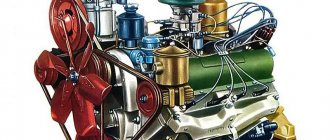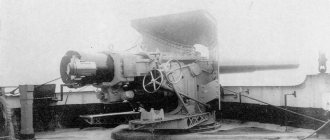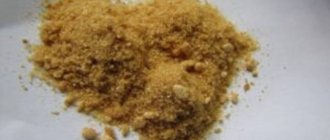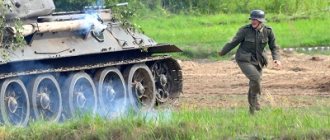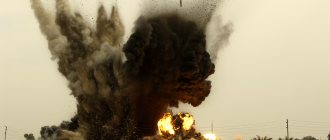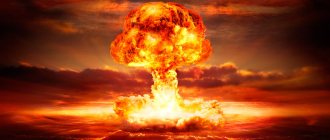Among the huge number of chemical substances, there is a group of specific substances that have a special chemical property - with certain changes in the physical state of the substance, an instant and active explosive reaction begins. The process occurs rapidly, within 1-5 milliseconds. This is precisely the description that characterizes explosives - products that appeared as a result of conscious human activity. One of the most powerful explosives is hexogen. At first glance, it is a white and harmless, powdery substance that has neither taste nor smell. In fact, this powder is capable of causing colossal destruction.
A banal and typical invention story
The end of the 19th century can be characterized by one short and succinct expression - the period of great inventions. However, as in most cases, the greatest discoveries made by man immediately took on a threatening direction. Everything that human thought created was immediately used for the subsequent invention by man of the most terrible and most powerful means of destroying his own kind. This fate did not spare the field of chemistry either. This science has made it possible for people to successfully fight terrible illnesses and, at the same time, to obtain the means to mercilessly destroy each other on the battlefields.
Chemists are among those scientists who think superficially about what they do. This was the case with the invention of hexogen. The German chemist Hans Genning managed to create a complex chemical substance with medicinal properties at the end of the 19th century. The scientist, confident in his good intentions, tried to create an effective drug that could make a real scientific breakthrough in medicine. Urolithiasis and inflammation of the genitourinary system have become a new scourge of modern human society. The lack of effective therapeutic agents for the treatment of ailments pushed scientists to search and create new medications.
The German managed to create hexogen, which was patented as a medicine in 1899. It should be noted that an analogue of hexogen, the drug urotropine or hexamethylenetetramine, was discovered back in 1859 by the Russian chemist A.M. Butlerov. From a medical point of view, the invention of the German chemist in those years did not lead to a noticeable breakthrough in urology. The use of the drug was accompanied by a large number of dangerous side effects, which at that time did not have a clear scientific explanation.
Hexogen (scientific name trimethylenetrinitroamine) is obtained as a result of a chemical reaction from methenamine and nitric acid. These components, in turn, can be easily obtained using coal, air and water. It follows from this that, by its chemical nature, the new substance has an unlimited resource. In the course of the first experiments, it was possible to obtain a finely crystalline substance of white color, which was distinguished by an absolutely amorphous state. Hexogen is insoluble in water, non-hygroscopic, and in its normal state of aggregation does not exhibit aggressive reactions. In addition, as it turned out, the substance does not interact with metals.
Problematic method
By the beginning of 1941, the NKRR was studying new processes. The Woolwich process or direct nitration process had at least two serious disadvantages: it used large amounts of nitric acid and dissolved at least half the formaldehyde. One mole of hexamethylenetetramine could produce no more than one mole of RDX. At least three laboratories without prior blasting experience were tasked with developing better production methods for RDX; they were founded at the public universities of Cornell, Michigan and Pennsylvania. Werner Emmanuel Bachmann of Michigan successfully developed a "combined process" by combining the Canadian process with direct nitration. The combination process required large quantities of acetic anhydride instead of nitric acid in the old British "Vulvist process". Ideally, the combination process can produce two moles of RDX for every mole of hexamethylenetetramine.
The huge production of RDX cannot continue to rely on the use of natural beeswax for desensitization. A petroleum-based stabilizer substitute has been developed at the Bruceton Explosives Research Laboratory.
Chemical and physical properties of hexogen
Despite its unique properties, hexogen remained a dark and unknown spot in military science for the military. Neither the Russo-Japanese War nor the First World War became a detonator in the field of development of explosives. Only in the 20s did the military pay attention to the unique chemical properties of this chemical.
The main chemical properties of hexogen that attracted the attention of the military were the stability of the substance and its high brisance. In addition, the substance was simple and accessible to obtain. The technology for producing RDX could be mastered even with a poorly developed chemical industry. In 1920, through the efforts of British chemists, it became possible to obtain the substance in a simpler way - nitration of hexamine with concentrated nitric acid. As a result of the experiments, the explosive properties of hexogen became clearly visible. From that moment on, specialists - pyrotechnicians - got to work.
It turned out that the substance is capable, under the influence of certain external factors, of transitioning from a calm state of aggregation to a rapid chemical transformation, accompanied by intense release of flammable gases. Moreover, this process occurs instantly within a thousandth of a second. It was discovered that hexogen, when detonated, generates a shock wave at supersonic speed. The gas pressure increases to large values in a matter of moments, forming an area of enormous destructive power. This type of explosion is typical for ammonite and TNT.
In order to activate the chemical reaction mechanism, it is necessary to provide an external influence. In the case of hexogen, such external factors may be:
- kinetic energy transferred by impact or friction;
- thermal effect exerted on a substance as a result of heat, sparks or open flame;
- a chemical reaction resulting from interaction with other chemicals;
- detonation effect caused by the blast wave of another explosive.
The recorded data from the experiments clearly demonstrated that a harmless white crystalline powder, designed to treat people from diseases of the genitourinary system, has colossal destructive power.
Pyrotechnicians were able to calculate the high explosiveness and brisance of hexogen. These two parameters characterize all explosives. It turned out that hexogen has twice the explosiveness of TNT. In other words, 10 g of hexogen at the moment of explosion releases 480 cm3 of flammable gases, while TNT upon detonation is capable of forming only 285 cubic meters. see gases. As for brisance, in this case the new substance is 1.26 times higher than the values obtained by detonating TNT. The detonation speed of hexogen is 8360 m/s, and a volume of gases is released equal to 908 l/kg.
The explosion of hexogen creates a pressure of 33.8 GPa along the front of the shock wave.
Such excellent parameters from the point of view of destructiveness could not be ignored by the military. In the early 30s, first in England and later in continental Europe, mass production of hexogen began, only as an explosive. Chemical production facilities have established a continuous cycle of nitration of hexamine, which made it possible to achieve large volumes of production of a new type of explosives in the shortest possible time.
It is noteworthy to pay attention to the economic indicators of hexogen production before the start of World War II by country. In England, 360 tons of hexogen were received per day, in the USA and Germany these figures were no less - 350 and 345 tons, respectively. In total, during the Second World War, the Third Reich produced 110 thousand tons of hexogen at its factories.
Further production
The NDRC commissioned three companies to develop pilot plants. These were: the Western Cartridge Company, E. I. du Pont de Nemours & Company, and the Tennessee Eastman Company, part of Eastman Kodak. At Eastman Chemical Company (TEC), a leading producer of acetic anhydride, Werner Emmanuel Bachmann developed a continuous process to create RDX. The RDX was critical to military operations, and its production process was too slow at the time. In February 1942, TEC began producing small volumes of RDX at its Wexler Bend pilot plant, which led to the U.S. government authorizing TEC to design and build the Holston Ordnance Works (HOW) in June 1942. By April 1943, the RDX was being produced there. At the end of 1944, the Woolwich process was producing 25,000 short tons (23,000 tons - 50 million pounds) of Composition B per month.
Practical application of RDX
It should be noted that the explosive substance, which includes hexogen, despite its high high explosiveness and brisiness, has never been used independently as an explosive. The only case of direct use of this explosive for military-technological purposes is the filling in capsules for cartridges and projectiles. Cases of practical use of this explosive as an independent explosive are of an applied nature. For technological purposes, hexogen is used only in combination with other explosives, together with which it forms an explosive of a certain type and type.
Common practice for making explosives involved mixing RDX with TNT. The proportion in this case was 50 to 50. Explosives are produced in which the percentage of hexogen content was 10-20% higher.
Today, the production of hexogen has been greatly simplified. It began to be obtained not from hexamine, but from the intermediate product of hexamine dinitrate and 35% nitric acid. The yield of hexogen in this case was no longer 10-35%, but twice as much. The percentage composition determines the presence of damaging factors of the explosive. So, for example, TG-50 explosive, in which TNT and hexogen are present in equal proportions, has a high explosive effect. The maximum heat is released at the moment of explosion for TGA-16 and A-IX-2 explosives, in which aluminum powder and aluminum powder and wax are added to TNT and hexogen.
In the second half of the 20th century, hexogen began to be used in the manufacture of plastite, plastic explosive PPV-4. Such mixtures in the form of putty have good plasticity and an adhesive base. In such mixtures, hexogen is contained in a ratio of 4 to 1 or 5 to 1 with respect to the binder. The most famous plastic explosive, which contains 94% hexogen, is C-4.
Comparison with other explosives
For clarity, we present a small table with the characteristics of various explosives. Let's take TNT as the “de facto standard”, RDX itself and a later explosive - octogen. Hexanitrohexaazaisowurtzitane will serve as a promising explosive.
| TNT (TNT) | Hexogen (RDX) | Octogen (HMX) | GNIV (CL-20) | |
| Density | 1.6 g/cm³ | 1.78 g/cm³ | 1.86 g/cm³ | 1.97 g/cm³ |
| Detonation speed | 6900 m/s | 8750 m/s | 9100 m/s | 9380 m/s |
| TNT equivalent | 1 | 1.6 | 1.7 | 2.0 |
It's easy to see that the RDX actually outperformed the TNT in terms of power. But octogen, even surpassing its predecessors in “explosive” qualities, still did not have such a decisive superiority, and turned out to be more difficult to manufacture. The complexity and high cost of manufacturing is still a barrier to the widespread distribution of the latest explosives. Even if new developments are much more powerful than RDX.
An analogue of hexogen that can completely displace it is considered to be the insensitive explosive FOX-7, obtained in Sweden in 1998. According to its characteristics, it is close to “composition B”, and its synthesis is simple. However, FOX-7 is produced on a small scale, and nothing is known about plans for its widespread use.
RDX today
Modern production of hexogen occurs in closed chemical plants. The independent combination of this explosive with other components is carried out only in industrial conditions using special equipment. When making explosives, RDX is painted orange and pressed. Today the following types of explosives are produced and used for military purposes. Explosives EVV, TGA. MS and TG-50 are equipped with a certain type of military ammunition. For example, the TG-50 makes up the charge in cumulative projectiles. Sea mines are equipped with MC explosives.
Unlike trinitrotoluene (TNT), the production of RDX is characterized by low profitability, which makes it the most widely used explosive today. High levels of high explosiveness and brisance make RDX a very convenient and effective explosive for the manufacture of special-purpose ammunition.
Bottom line
The United Kingdom's goal in World War II was to use "desensitized" RDX. In Woolwich's original RDX process, RDX was phlegmatized with beeswax, but later paraffin wax was used, based on work done at Bruceton. In the event that Britain was unable to obtain enough RDX to meet its needs, some of the shortcomings of the production methods were corrected by replacing amatol, a mixture of ammonium nitrate and TNT. This information will be useful to anyone who still does not know what hexogen is.
Application[ | ]
Used for the manufacture of detonators (including detonation cords) for ammunition and for blasting operations in industry, as a rule, in a mixture with other substances (TNT, etc.), as well as with the addition of phlegmatizers (paraffin, wax, ceresin) , reducing the danger of a RDX explosion from accidental causes. For example, the well-known C-4 is 91% RDX, 2.25% polyisobutylene, 5.31% dioctyl sebacate and 1.44% liquid lubricant.
It can also be used as a propellant component in solid rocket motors.
A-IX-2 or how Ledin solved an unsolvable problem
37 trainers in cs:go were banned for using a bug.
It wasn’t engineer Ledin who struck TGA specialists with explosives, it was his warm-up. By 1941, he had solved a problem that chemists from all countries had been unsuccessfully struggling with for 30 years, and by that time this problem had begun to be considered insoluble in principle. That's the problem.
By the beginning of the century, black powder in artillery shells began to be replaced with stronger explosives. Trinitrotoluene (TNT, tol) became the ideal explosive for these purposes. It is safe to use, reliable, and easily poured into projectile bodies. It is ideal for almost all types of projectiles... except armor-piercing ones.
When a projectile falls to the ground, when it hits not very hard obstacles, trinitrotoluene withstands the shock and explodes only when it is detonated by the fuse detonator. But an armor-piercing projectile flies at a very high speed, and its impact on the armor is very sharp. Trinitrotoluene does not withstand the impact and explodes immediately. The projectile breaks down on the armor and cannot penetrate the armor.
To prevent trinitrotoluene from exploding prematurely, phlegmatizers are introduced into it - substances that make explosives more resistant to impact. But at the same time, the power of the explosion drops almost to the power of black powder. Chemists took more powerful explosives, but they are practically still more delicate and no longer withstand not only a blow to the armor, but even the shock of a shot - they explode right in the gun barrel. Such explosives, so that they do not explode prematurely, need to be injected with phlegmatizers in increased volumes, after which the power of their explosion becomes like that of trinitrotoluene - the game is not worth the candle. From the turn of the century to the beginning of World War II, chemists tried everything and came to the conclusion that this problem could not be solved.
So, in 1938, Ledin undertook to invent an explosive for armor-piercing shells that would be twice as powerful as trinitrotoluene! When he developed the technical specifications for this substance, all scientists, professors and other specialists simply considered him an illiterate fool. But since Ledin was a civilian employee at a military laboratory, his superiors did not mind him “playing around” with solving an unsolvable problem.
At this time, trouble happened - Ledin was drafted into the army. There was a great need for specialists in the laboratory, and his superiors offered to give him the rank of officer and include him in the laboratory staff. He would have been provided with an apartment, a high salary, rations, etc. and so on. But in this case, Ledin would no longer be able to work on his explosives and would be forced to work according to the laboratory plan. And Ledin refuses to become an officer. He is called up to serve as a sailor, but, however, the laboratory is trying to get him to serve with it. Now Ledin does not have enough money to rent an apartment and support his family. He sends the child to his mother, he and his wife spend the night in the corners of friends, changing these corners every night. But Ledin works hard on his invention and by the beginning of the war he creates an explosive that can withstand the impact of a shell on armor, but is more than 2 times more powerful than trinitrotoluene!
For this reason alone, Ledin is an outstanding Soviet engineer and scientist! But that's not all...
The shells, filled with Ledin's explosives (he called it A-IX-2), began to have such a high explosion temperature that they set fire to everything inside the tank that could burn. Because of this, at one time they were also called incendiary. And anti-aircraft shells equipped with this explosive sharply increased their effectiveness: there was a case when one successfully sent 130-mm shell immediately shot down a flight of 3 German bombers. If the shooting took place at night, the flashes of explosions were so bright that the German pilots became blind and could no longer see the ground, instruments, or neighboring aircraft. But that's still not all.
When the Germans obtained these armor-piercing shells of ours, equipped with Ledin explosives, German chemistry tried to reproduce it. Captured after the war, a report from the German Chemisch-Technische Reichanstalt Institut begins with Hitler's order to reveal the secret of Ledeen's explosives. The report describes the enormous work of German chemists to unravel the secret of this explosive. Of course, they immediately understood what it was made of. But how Ledin created it, they could not understand until the end of the war. Chemists from NATO, the USA, Europe and the whole world took up the baton from the Germans. Useless!
The USSR managed to keep the secret, and for 50 years the Soviet Army had the most powerful armor-piercing shells and missile warheads in the world!
Engineer Ledin was 50 years ahead of his colleagues around the world, and if the USSR had not been destroyed and the secret of explosives had not been sold to the West, then perhaps this figure would have doubled.
Why is it dangerous for humans?
Hexogen has a fairly powerful toxic effect. Symptoms of acute poisoning appear as follows:
The maximum permissible concentration of hexogen in the blood for the human body is 0.001 mg/l, which is similar to the values for phenol.
Inhalation poisoning with hexogen is especially dangerous. The substance is easily absorbed into the lungs and enters the bloodstream, bypassing the liver. Maximum concentration is achieved instantly. Gastric lavage, regardless of the method of administration of the substance, is effective, since a balance is established in the concentrations of the substance in the blood and in the gastric contents. But inducing vomiting is highly not recommended!
Source
Notes
- [dic.academic.ru/dic.nsf/enc3p/321038 CYCLOTRIMETHYLENETRINITRAMINE]. Big Encyclopedic Dictionary
(2000). Retrieved June 28, 2014. - [institutebishop.org/Reactions_Energy_Redox_Explosives_Science.pdf An Introduction to Chemical Reactions, Energy, Gases, and Chemical Explosives], Mark Bishop: “Research Department Explosive, RDX (T4) High detonation velocity ( 8700 m/s) Relative effectiveness factor of 1.6 »
| : Incorrect or missing image | To improve this article it is desirable:
|
Why is it dangerous for humans?
Hexogen has a fairly powerful toxic effect. Symptoms of acute poisoning appear as follows:
The maximum permissible concentration of hexogen in the blood for the human body is 0.001 mg/l, which is similar to the values for phenol.
Inhalation poisoning with hexogen is especially dangerous. The substance is easily absorbed into the lungs and enters the bloodstream, bypassing the liver. Maximum concentration is achieved instantly. Gastric lavage, regardless of the method of administration of the substance, is effective, since a balance is established in the concentrations of the substance in the blood and in the gastric contents. But inducing vomiting is highly not recommended!
Source
HMX
In 1942, the American chemist Bachmann, while conducting experiments with hexogen, accidentally discovered a new substance, octogen, in the form of an impurity. He offered his find to the military, but they refused. Meanwhile, several years later, after it was possible to stabilize the properties of this chemical compound, the Pentagon became interested in octogen. True, it was not widely used in its pure form for military purposes, most often in a cast mixture with TNT. This explosive was called "octolome". It turned out to be 15% more powerful than hexogen. As for its effectiveness, it is believed that one kilogram of HMX will produce the same amount of destruction as four kilograms of TNT.
However, in those years, the production of HMX was 10 times more expensive than the production of RDX, which hindered its production in the Soviet Union. Our generals calculated that it was better to fire six shells with hexogen than one with octol. This is why the explosion of an ammunition depot in Vietnamese Qui Ngon in April 1969 cost the Americans so much. At the time, a Pentagon spokesman said that due to guerrilla sabotage, the damage amounted to $123 million, or approximately $0.5 billion in current prices.
In the 80s of the last century, after Soviet chemists, including E.Yu. Orlov, developed an effective and inexpensive technology for the synthesis of octogen, and it began to be produced in large quantities here.
Structural isomerism
Hexane is characterized by structural isomerism - isomerism of the carbon skeleton.
Structural isomers are compounds with the same composition that differ in the order of bonding of atoms in the molecule, i.e. the structure of molecules.
Carbon skeleton isomers differ in the structure of the carbon skeleton.
| For example. For hydrocarbons with the composition C6H14, there are five isomers of the carbon skeleton: n-hexane, 2-methylpentane, 3-methylpentane, 2,2-dimethylbutane, 2,3-dimethylbutane |
| Hexane | 2-Methylpentane |
| CH3-CH2-CH2-CH2-CH2-CH3 | CH3-CH(CH3)-CH2-CH2-CH3 |
Pentane is not characterized by spatial isomerism.
Opening
Hexogen was created in 1898 by Georg Friedrich Henning, who received a German patent (patent no. 104280) for its manufacture by nitrolysis of hexamine (hexamethylenetetramine) with concentrated nitric acid. This patent mentioned the medicinal properties of the substance; however, three more German patents obtained by Henning in 1916 described RDX as a substance suitable for use in smokeless propellants. The German military began research into its use in 1920, referring to it as RDX. The results of the research and development were not published until Edmund von Hertz, described as an Austrian and later German citizen, was granted a British patent in 1921 and a United States patent in 1922. Both patent applications were pending in Austria. British patent applications included the production of the explosive RDX by nitration, its use with or without other explosives, as an explosive charge and as a detonator. The US patent application was for the use of a hollow explosive device containing RDX and a detonator cap containing RDX. In the 1930s, Germany developed improved methods for producing RDX.
Symptoms of acute poisoning:
Animals.
The clinical picture was dominated by tonic convulsions. Doses of 0.02-0.15 g/kg caused the death of all mice within a month. An autopsy revealed cerebral edema and degeneration of internal organs. Oral poisoning of rabbits with a dose of 7.0 mg/kg daily for 160 days caused lymphocytosis and liver dysfunction. In dogs, long-term administration of 0.1-1.0 mg/kg leads to impaired locomotor function.
Human.
Some of the workers involved in drying and sifting RDX experienced attacks of poisoning: headache, dizziness, nausea, sweetish taste and a feeling of dry mouth, thirst, weakness, twitching of the whole body or arms, legs, head. In more severe cases - loss of consciousness, cyanosis of the face and limbs, convulsions, followed by repeated vomiting. In this case, disorders of the autonomic nervous system are noted (increased pilomotor reaction, sweating, increased or slow heart rate, increased body temperature, severe dermographism, frequent urge to urinate), and sometimes sleep disturbance. In some victims, attacks are preceded by fear, melancholy, tearfulness, and, less commonly, hallucinations. Such attacks occurred more often in the first 6-8 months of work during the working day or a few hours after finishing work and even after 1-2 days of rest, which apparently indicates the accumulation of RDX in the body. In some individuals, attacks were repeated up to 5 times while working with hexogen. After stopping work with hexogen, the poisoning phenomena quickly disappeared.




